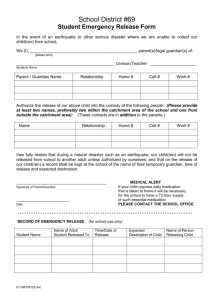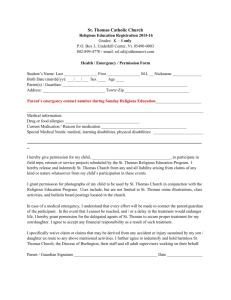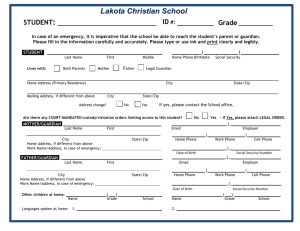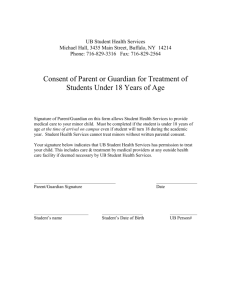behavior control interventions
advertisement
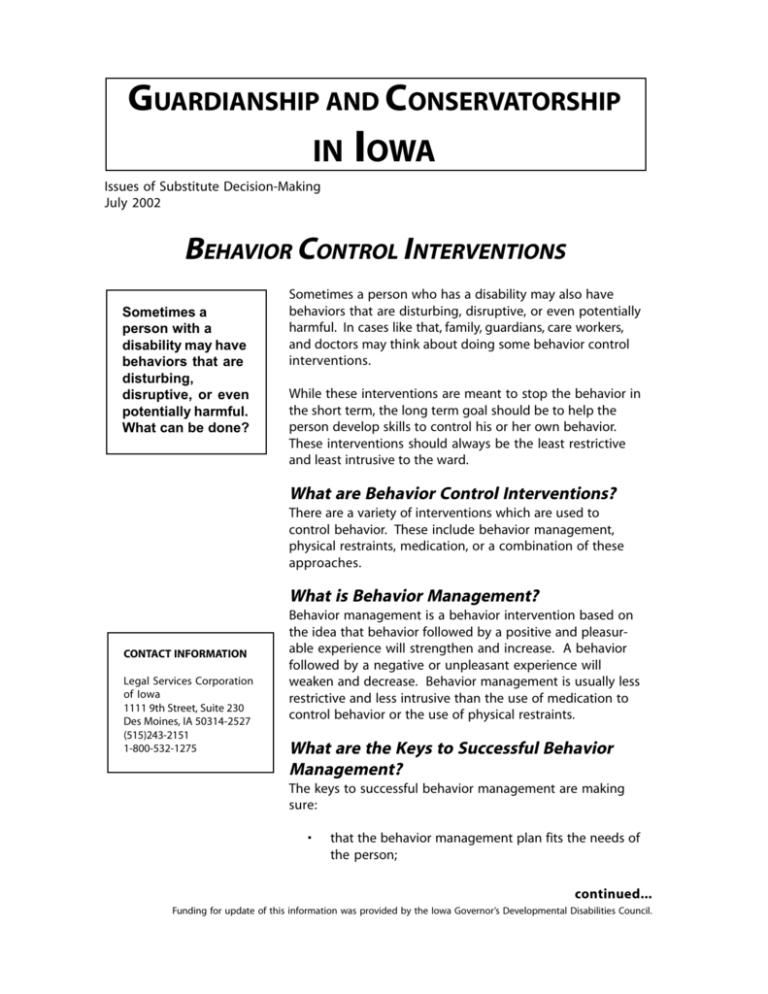
GUARDIANSHIP AND CONSERVATORSHIP IN IOWA Issues of Substitute Decision-Making July 2002 BEHAVIOR CONTROL INTERVENTIONS Sometimes a person with a disability may have behaviors that are disturbing, disruptive, or even potentially harmful. What can be done? Sometimes a person who has a disability may also have behaviors that are disturbing, disruptive, or even potentially harmful. In cases like that, family, guardians, care workers, and doctors may think about doing some behavior control interventions. While these interventions are meant to stop the behavior in the short term, the long term goal should be to help the person develop skills to control his or her own behavior. These interventions should always be the least restrictive and least intrusive to the ward. What are Behavior Control Interventions? There are a variety of interventions which are used to control behavior. These include behavior management, physical restraints, medication, or a combination of these approaches. What is Behavior Management? CONTACT INFORMATION Legal Services Corporation of Iowa 1111 9th Street, Suite 230 Des Moines, IA 50314-2527 (515)243-2151 1-800-532-1275 Behavior management is a behavior intervention based on the idea that behavior followed by a positive and pleasurable experience will strengthen and increase. A behavior followed by a negative or unpleasant experience will weaken and decrease. Behavior management is usually less restrictive and less intrusive than the use of medication to control behavior or the use of physical restraints. What are the Keys to Successful Behavior Management? The keys to successful behavior management are making sure: • that the behavior management plan fits the needs of the person; continued... Funding for update of this information was provided by the Iowa Governor’s Developmental Disabilities Council. • that alternative, appropriate, or positive behavior skills are developed as part of the behavior management plan, as well as concentrating on reducing the negative or undesired behavior; deprive the person of access to an activity or property/object, or before using physical or mechanical types of restraints. For example, physical restraints such as a “poesy” for use in a wheelchair, would be considered a mechanical restraint. • to understand what the person may be trying to communicate through the inappropriate behavior; and • to discover what in the person’s situation or environment may be reinforcing the behavior and causing it to continue, and then planning to change that part of the environment or situation. A doctor may prescribe the use of restraints for medical purposes. But there may be occasions when care staff use this type of restraint to control a person because it is easier than engaging the person in some other appropriate or needed activity. When considering the use of any behavior management intervention, it is important to realize that some behaviors will not be reduced or eliminated and may increase. This is most common in persons who have Alzheimer’s Disease or other related dementia diseases. This also occurs in some people who develop permanent side effects from long-term administration of certain psychotropic medications. In these cases, the goals and outcomes of behavior management will focus more on helping the person avoid harm or danger to self and/or others, not on reduction and elimination of the behavior. When is Behavior Management Really Necessary? The guardian should closely follow the use of any behavior management programming to make sure that it meets the needs and is in the best interest of the ward. The guardian should also be aware that such techniques may be used more for the convenience of care staff than for the best interest of the ward. Under federal regulations for nursing homes, informed consent from the guardian must be given before the facility can restrict or This may happen more frequently in care facilities or by in-home care providers where care staff are untrained and underpaid, or there is not enough staff to attend to all the people for whom they are responsible. In any situation, the guardian must be informed about the use of the restraint and given information about how and why it is being used before giving consent for its use. What Are the Ward’s Rights When a Behavior Management Plan is Used? All licensed service providers operate under specific regulations which allow them to perform certain functions, but which also protect the rights of the person receiving the service. The guardian should become familiar with the rights related to any service the ward may receive. Also, the guardian should ask the service provider to give him/her a written copy of the rights of person receiving their services and ask them to explain any portion which the guardian does not understand. What if the Ward’s Behavior is Very Challenging? When a person’s behavior may cause immediate harm to him or herself or to others, some form of physical restraint may be used to control the behavior. This is designated as continued... “aversive and deprivation” intervention. This describes a category of techniques and procedures applied under the general term “behavior management” or “behavior intervention.” It is used when general behavior management techniques are not enough to control dangerous or challenging behavior. Physical and mechanical restraint procedures fall under this category. ness of the treatment to ensure that it is of benefit to the person. The guardian who has been given the power to consent to medical treatment has the authority to refuse the use of medication, as well as agree to the use of this class of medications. The guardian should include all medication strategies and results in the annual report which he or she submits to the court. Aversive and deprivation procedures combined with positive approaches have been effective in reducing, and in some cases eliminating, challenging behavior. Most often it serves to protect the person, property, or others from injury or harm. The use of aversive or deprivation procedures is not generally recommended unless other less-restrictive and positive methods have been tried first. It must be used under the supervision of a person trained in behavior management and behavior analysis. All parts of the behavior reduction plan must be specifically related to the person’s own needs and closely monitored. Behavior Management Consent Checklist Before consenting to the use of any behavior management intervention, including aversive or deprivation procedures, make sure that there is careful planning and the least restrictive or least aversive interventions are tried first. To assist the guardian in making these decisions, a checklist has been developed. If the guardian answers “no” to many of these questions, he or she may want to reconsider the use of the behavior management intervention plan or aversive or deprivation procedures. • Does staff have reasonable knowledge of behavior management techniques? Any guardian who makes decisions for an individual is naturally concerned with choices regarding behavior-altering medication. These medications are called “psychotropics.” A subclass of these medications is called “neuroleptic” medications. Psychotropic medication will not necessarily solve or eliminate all problems an individual is facing, yet it may be unfair to deprive an individual of medication which can assist in the person’s life. It is how the medication is used that is the key. • If aversive and deprivation procedures are being planned, are they truly the “last resort”? Has there been a succession of well-designed, positive behavior management techniques which have been completely implemented and found unsuccessful? • Have staff been instructed on how to develop non-aversive, positive programs for challenging behaviors? What Happens After Consenting to the Use of Medication? • Have the possible side effects of medication, behavioral techniques, deprivation, and aversive intervention been fully discussed? What, if Any, Medication is Recommended to Control Behavior? The guardian needs to continue monitoring the use of this medication. Consenting to the use of the medication is the beginning of an ongoing process of evaluating the effective- continued... • Will the care giver be able to implement these methods in the ward’s home? What will happen if the care giver cannot or does not want to implement the programs? • Can the behavior management procedure be used in all the settings in which the ward exhibits the behavior? _ Is the environment in which the ward resides or receives services stimulating and supportive? _ Is the guardian sure that the disruptive behaviors are not the result of frustration? Communication limitations? Lack of alternative means to express anger? Refusal? Boredom? The result of untreated illness or pain? _ Is the facility or program including the guardian in its planning for behavior management procedures? _ Have staff been instructed on how to perform the procedure? _ Do staff have resources available for consultation, such as a social worker, a psychologist, or psychiatrist? _ Does the guardian feel that the ward’s dignity is being maintained throughout both the planning process and the administration of the behavior management procedures? _ Has the ward recently experienced life events which would explain the behavior? Behavior Medication Consent Checklist If the guardian is requested to consent to the use of medication to treat a person’s behavior, the guardian must make sure that they have appropriate information in order to give informed consent. These questions may help in determining whether a guardian has sufficient information to make this decision. _ What are the specific behaviors or statements of the individual that the medication is to change? If there is a psychiatric diagnosis, what are the specific behaviors that the medication is to change? _ What information or data is recorded and collected and used to monitor the behavior in order to determine if the psychotropic medication is having its desired effect? Is the data “opinion” or actually observed behavior? Is the data shared with the guardian? _ What are the specifics of the medication - the dose, the possible dose range, the route of administration, the expected duration? How long is it to be used before deciding whether it is working or not? _ What are the side effects and risks of the medication? How are they treated? Is the person at higher risk for some of the side effects? _ How will the medication be monitored? What is the monitoring system? What specific assessment tools are used to check for side effects? How often are they used? How will the guardian be informed if side effects are observed? _ What other behavior management techniques are being used along with the use of the psychotropic medication? What kind of educational, environmental, or skill-building efforts are also in place? Have these been considered and properly addressed? continued... • Is the lowest effective does of the medication being used? If attempts tolower the dosage are made, are these done very gradually in order to prevent withdrawal reactions? • Are medication changes occurring without the guardian being informed? Are too many “emergencies” occurring and medication being started without the guardian’s consent? • The most important question: How is the ward doing when the guardian sees the ward and observes daily activities? Is the ward participating in activities to the extent of their ability? Is the behavior still interfering with life despite the medication? Are side effects present and interfering with life activities? These materials are a general summary of the law. They are not meant to completely explain all that you should know about guardianship and conservatorship. You should see a lawyer to get complete, correct and up-to-date legal advice.
